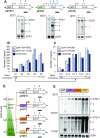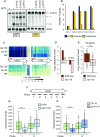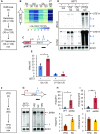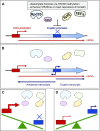Core promoter activity contributes to chromatin-based regulation of internal cryptic promoters
- PMID: 34320189
- PMCID: PMC8373055
- DOI: 10.1093/nar/gkab639
Core promoter activity contributes to chromatin-based regulation of internal cryptic promoters
Abstract
During RNA polymerase II (RNA Pol II) transcription, the chromatin structure undergoes dynamic changes, including opening and closing of the nucleosome to enhance transcription elongation and fidelity. These changes are mediated by transcription elongation factors, including Spt6, the FACT complex, and the Set2-Rpd3S HDAC pathway. These factors not only contribute to RNA Pol II elongation, reset the repressive chromatin structures after RNA Pol II has passed, thereby inhibiting aberrant transcription initiation from the internal cryptic promoters within gene bodies. Notably, the internal cryptic promoters of infrequently transcribed genes are sensitive to such chromatin-based regulation but those of hyperactive genes are not. To determine why, the weak core promoters of genes that generate cryptic transcripts in cells lacking transcription elongation factors (e.g. STE11) were replaced with those from more active genes. Interestingly, as core promoter activity increased, activation of internal cryptic promoter dropped. This associated with loss of active histone modifications at the internal cryptic promoter. Moreover, environmental changes and transcription elongation factor mutations that downregulated the core promoters of highly active genes concomitantly increased their cryptic transcription. We therefore propose that the chromatin-based regulation of internal cryptic promoters is mediated by core promoter strength as well as transcription elongation factors.
© The Author(s) 2021. Published by Oxford University Press on behalf of Nucleic Acids Research.
Figures






Similar articles
-
Relationships Between RNA Polymerase II Activity and Spt Elongation Factors to Spt- Phenotype and Growth in Saccharomyces cerevisiae.G3 (Bethesda). 2016 Aug 9;6(8):2489-504. doi: 10.1534/g3.116.030346. G3 (Bethesda). 2016. PMID: 27261007 Free PMC article.
-
The Histone Chaperones FACT and Spt6 Restrict H2A.Z from Intragenic Locations.Mol Cell. 2015 Jun 18;58(6):1113-23. doi: 10.1016/j.molcel.2015.03.030. Epub 2015 May 7. Mol Cell. 2015. PMID: 25959393 Free PMC article.
-
Spt6 Is Required for the Fidelity of Promoter Selection.Mol Cell. 2018 Nov 15;72(4):687-699.e6. doi: 10.1016/j.molcel.2018.09.005. Epub 2018 Oct 11. Mol Cell. 2018. PMID: 30318445 Free PMC article.
-
[Molecular mechanisms of transcription through a nuclesome by RNA polymerase II].Mol Biol (Mosk). 2013 Sep-Oct;47(5):754-66. Mol Biol (Mosk). 2013. PMID: 25509347 Review. Russian.
-
The role of FACT in managing chromatin: disruption, assembly, or repair?Nucleic Acids Res. 2020 Dec 2;48(21):11929-11941. doi: 10.1093/nar/gkaa912. Nucleic Acids Res. 2020. PMID: 33104782 Free PMC article. Review.
Cited by
-
N-terminal acetylation of Set1-COMPASS fine-tunes H3K4 methylation patterns.Sci Adv. 2024 Jul 12;10(28):eadl6280. doi: 10.1126/sciadv.adl6280. Epub 2024 Jul 12. Sci Adv. 2024. PMID: 38996018 Free PMC article.
References
Publication types
MeSH terms
Substances
LinkOut - more resources
Full Text Sources

